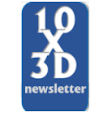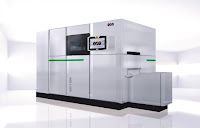Some suggestions and recommendations for 3D printing equipment for medical teams (COVID-19 Supply Chain)
 Many
surprises pop up and appear during the Corona Virus crisis. For example, an
average scooter
Many
surprises pop up and appear during the Corona Virus crisis. For example, an
average scooter rider in Tel Aviv streets seems to be better protected than the medical
staff in hospitals. The highest concentration of verified and blast-infected
patients are high in hospitals, and while patients may no longer be able to
infect each other, the medical teams treating them are in the "Ground
Zero" in terms of the proximity to the viruses. They exposed to infection
at any given moment. When Medical personnel, becoming infected with corona, it immediately
removes him from treating patients. While the pool of potential patients is growing
more and more, the medical personnel workforce is a given and final number
.
Imagine,
what would have happened if an airline operations center would have operated as
a hospital, then an aircrew would have flown directly to New York, stopping for
five minutes at the airport. Later the same crew would fly the return flight
back without any rest. On the way back, the pilots would switch to autopilot,
asking the flight attendant to wake them up if there was anything unusual and
going to sleep. Imagine the Cockpit crew did not have any emergency equipment
such as oxygen masks or rescue belts for the pilots, and if it did, then in a
reduced amount, that was enough for only one pilot. The flight attendants would
find it difficult to get through to the rear part of the plane because of all
the passengers sitting on the floor and blocking the aisles. After four hours
the plane would drop to 8,000 feet and fly without diffusion because the system
was leaking, with the approach to the airport, the pilots would turn off
engines and glide towards the runway because there was not enough fuel. During
the holidays period, the pilots would just stay and sleep in the planes between
the rounds of flights.
Many
countries around the world have not yet assimilated the idea that medical personnel
is not disposable and that patients’ lives depend on the availability and
competence of medical personnel. Technological solutions for protecting the medical
teams are known and exist; however, the quantity of equipment is insufficient and
does not cover the entire medical team. Frequently, the equipment has never
been tested, and the team is not well trained using it. When all countries keep
their own small inventory, and import and export are almost entirely blocked,
the immediate and necessary solution is turning to local production of the
missing equipment, and this need for quick and domestic production is exceedingly
consistent with 3D printing. Leading the trend of completing 3D printing
equipment is the Maker communities and Makerspaces, which means a lot of people
from different places, with goodwill, free time, enthusiasm, and access to 3D
printers. This large community is willingly ready to help the medical personnel,
so they have already started to download programs, design, print, and assemble the
amounts of protective equipment in local production. Every day, various
projects are published online, and due to the lack of protective equipment, improvised
solutions have already come into use, such as the conversion of water sports
equipment or homemade face masks (PPE) and face protection. Those home-based
manufacturers, inspired by the Playmobil characters of children game, probably believe
the medical teams should be protected and look like Bob The Builder. Medical
workers are not firefighters, divers, or pest control workers, and
unfortunately, the solutions of how to protect the medical teams are not
supposed to be inspired by children’s games or cartoon films. If we do not want
further shorten the "shelf life" of hospital workers, then it is
worth considering a few essential things before pushing equipment into their
hands that may endanger them and the people around them.
 |
| 3D printed PPE |
I
encourage you to pay attention to the following highlights before you
manufacture or use such improvised solutions:
A. Quality
control - Home printed, machine accessory, face protection shields, or
airflow connector, make me very uncomfortable for the following reasons. A home
manufacturer has no control or tracking over the raw material, its components,
and quality, nor does it have any control over the production and packaging
process. It also cannot provide a sterilization protocol for the parts. Are the
parts cleanable? What about water or air tightness testing? The entry-level manufacturing
technology also cannot guarantee the same quality for every 3D part, even the
same printer, and with the same parameters, not to mention printers on
different websites. Think for a moment about a situation where twenty
home-based manufacturers are supplying 1,000 shields to hospitals. After the
delivery, it turns out that one of the suppliers detected with the Corona Virus.
What can you do now? How do you know how to collect suspicious parts? What
happens if one of the 3D parts found contaminated? How to find the whole
series? Established companies that work according to standard and following
regulatory quality control procedures use standardized work procedures and can
work with adherence to health system requirements. These procedures are often
written in the blood and aim to maintain public health.
 |
| a single 60 Micrometer printing layer Compared to 0.125 Mm CoronaVirus |
B. Sterilization
cleanses - The printed parts are designated to use in a virus-contaminated
environment, so they will probably be contaminated as well. In most printing
methods, the resulting plastic parts are porous material,
which can serve as an excellent substrate for the adsorption of impurities and
a significant challenge for cleaning and sterilization. In an efficient and
organized production, the manufacturer should provide thorough information concerning
the cleaning method, the shelf life of the part, and the expiry date.
C. Printing
method and raw materials - The most commonly used printing method,
especially in the domestic environment, is called FDM or FFF. It is also a challenging
technology when used to create products for the medical environment. With this
printing method, printers are being fed with plastics wire from a spool that is
heated and compressed on the printer bed surface layer after layer. The two
common materials used on home printers are ABS and PLA, which is considered
safe and more comfortable to use. Home users use materials from unknown sources
without control over the composition of the material and adapt it to the
intended use. The filament deposition printing method creates a model that often
does not seal for water or air tightness, meaning that the parts leak, and the
layers destined quickly to be contaminated. Therefore, the attempt to make
masks with N95 protection by this method is not responsible.
 |
|
|
Another
conventional manufacturing technology is SLA or DLP. This method uses
photopolymer resin as the printing material, which is a thick liquid that
becomes solid in exposure to UV light. The resulting models can be opaque and it already been used to 3D Printed Nasal Swabs. Most
materials in this method were not approved for prolonged contact with the skin.
In the professional field, resin with certificates used for dental medicine
that will also be more tolerable for other medical uses. The parts obtained by
this method are fragile, are not durable for long periods, and continue to
harden with light exposure.
The most suitable production method for printing durable plastic parts is the SLS
or its relative, the HP MJF. The common material ideal for manufacturing of
medical products by the above methods is nylon 12, also called polyamide 12 or
PA12. Some of the printer manufacturers have been approved by the US Food and
Drug Administration for use in this material in medical and food applications for
contact with human skin for a short time, and food containers (not alcohol).
For more information on Medical Compliance - EOS, HP.
So what can be done?
3D
printing is an excellent tool for developing prototype production, and tools
for other manufacturing methods, such as printing a model for using flexible
molds (silicone molds). When producing print parts that should be used as a
final product, it is essential to thoroughly examine where and what the use of
the piece is and what are the requirements for it.
Various
air and oxygen pipe connectors should be tested for air pressure compliance and
leakage testing at interfaces. Some professional service bureaus have people
with experience and knowledge in this field. It is recommended to produce the
parts only with them. Parts that come into contact with the skin should be made
of approved material or coated with one. Home production in an unsupervised
environment is not recommended, and in any case, all precautions should be
taken when printing parts to prevent the spread of infections.
A 3D
printed parts manufacturer should be able to provide proven information on the
raw material source, cleaning method, and sterilization of the manufactured
parts. Exterior parts are recommended to be painted with a special primer and
opaque paint layer that could be sterilized with 70% alcohol.
 Food
and Drug Administration, the US FDA, provides several guidelines on the issue and It also provides flexibility for crisis days.
Food
and Drug Administration, the US FDA, provides several guidelines on the issue and It also provides flexibility for crisis days.
If
you have access to a Decathlon or Ocean Reef snorkel mask, and you would like to convert it to a
medical oxygen mask for a patient or personnel member, please refrain from printing
the necessary adaptors domestically. Ocean Reef did release the 3D
files online,
but because of the demand, it has begun producing the parts itself,
providing a quantity of 1,000 pieces a day, and it sends them all over the world.
To improve the opacity of printed parts and enable
Sterilization is recommended to consider metallic coating as a complementary treatment.
Polymertal is one of the companies that specialize in this type of treatment.
Gal Raz





























